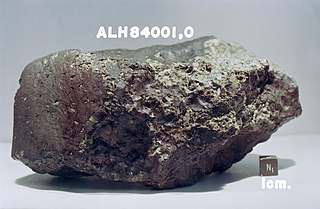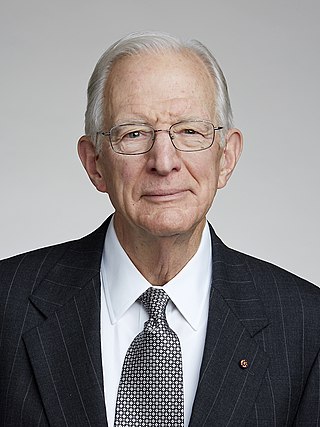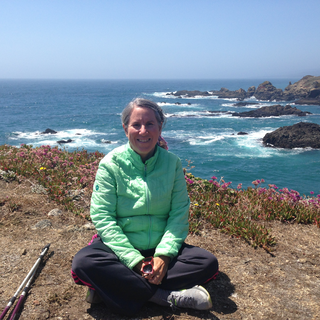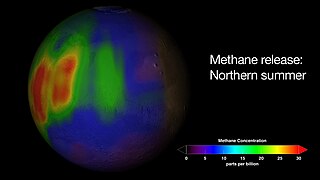Related Research Articles

Astrobiology is a scientific field within the life and environmental sciences that studies the origins, early evolution, distribution, and future of life in the universe by investigating its deterministic conditions and contingent events. As a discipline, astrobiology is founded on the premise that life may exist beyond Earth.

Allan Hills 84001 (ALH84001) is a fragment of a Martian meteorite that was found in the Allan Hills in Antarctica on December 27, 1984, by a team of American meteorite hunters from the ANSMET project. Like other members of the shergottite–nakhlite–chassignite (SNC) group of meteorites, ALH84001 is thought to have originated on Mars. However, it does not fit into any of the previously discovered SNC groups. Its mass upon discovery was 1.93 kilograms (4.3 lb).

The possibility of life on Mars is a subject of interest in astrobiology due to the planet's proximity and similarities to Earth. To date, no proof of past or present life has been found on Mars. Cumulative evidence suggests that during the ancient Noachian time period, the surface environment of Mars had liquid water and may have been habitable for microorganisms, but habitable conditions do not necessarily indicate life.
A biosignature is any substance – such as an element, isotope, or molecule – or phenomenon that provides scientific evidence of past or present life. Measurable attributes of life include its complex physical or chemical structures and its use of free energy and the production of biomass and wastes. A biosignature can provide evidence for living organisms outside the Earth and can be directly or indirectly detected by searching for their unique byproducts.

In 1976 two identical Viking program landers each carried four types of biological experiments to the surface of Mars. The first successful Mars landers, Viking 1 and Viking 2, then carried out experiments to look for biosignatures of microbial life on Mars. The landers each used a robotic arm to pick up and place soil samples into sealed test containers on the craft.
The NASA Astrobiology Institute (NAI) was established in 1998 by the National Aeronautics and Space Administration (NASA) "to develop the field of astrobiology and provide a scientific framework for flight missions." In December 2019 the institute's activities were suspended.

Geobiology is a field of scientific research that explores the interactions between the physical Earth and the biosphere. It is a relatively young field, and its borders are fluid. There is considerable overlap with the fields of ecology, evolutionary biology, microbiology, paleontology, and particularly soil science and biogeochemistry. Geobiology applies the principles and methods of biology, geology, and soil science to the study of the ancient history of the co-evolution of life and Earth as well as the role of life in the modern world. Geobiologic studies tend to be focused on microorganisms, and on the role that life plays in altering the chemical and physical environment of the pedosphere, which exists at the intersection of the lithosphere, atmosphere, hydrosphere and/or cryosphere. It differs from biogeochemistry in that the focus is on processes and organisms over space and time rather than on global chemical cycles.
γ-Carotene (gamma-carotene) is a carotenoid, and is a biosynthetic intermediate for cyclized carotenoid synthesis in plants. It is formed from cyclization of lycopene by lycopene cyclase epsilon. Along with several other carotenoids, γ-carotene is a vitamer of vitamin A in herbivores and omnivores. Carotenoids with a cyclized, beta-ionone ring can be converted to vitamin A, also known as retinol, by the enzyme beta-carotene 15,15'-dioxygenase; however, the bioconversion of γ-carotene to retinol has not been well-characterized. γ-Carotene has tentatively been identified as a biomarker for green and purple sulfur bacteria in a sample from the 1.640 ± 0.003-Gyr-old Barney Creek Formation in Northern Australia which comprises marine sediments. Tentative discovery of γ-carotene in marine sediments implies a past euxinic environment, where water columns were anoxic and sulfidic. This is significant for reconstructing past oceanic conditions, but so far γ-carotene has only been potentially identified in the one measured sample.

Extraterrestrial material refers to natural objects now on Earth that originated in outer space. Such materials include cosmic dust and meteorites, as well as samples brought to Earth by sample return missions from the Moon, asteroids and comets, as well as solar wind particles.

Bruce Norman Runnegar is an Australian-born paleontologist and professor at UCLA. His research centers on using the fossil record to determine how, where, and when life originated and evolved. He has published on a wide variety of topics, including the phylogeny of molluscs, Dickinsonia fossils and oxygen levels, and molecular clock techniques.

Yamato 000593 is the second largest meteorite from Mars found on Earth. Studies suggest the Martian meteorite was formed about 1.3 billion years ago from a lava flow on Mars. An impact occurred on Mars about 11 million years ago and ejected the meteorite from the Martian surface into space. The meteorite landed on Earth in Antarctica about 50,000 years ago. The mass of the meteorite is 13.7 kg (30 lb) and has been found to contain evidence of past water alteration.
Katherine H. Freeman is the Evan Pugh University Professor of Geosciences at Pennsylvania State University and a co-editor of the peer-reviewed scientific journal, Annual Review of Earth and Planetary Sciences. Her research interests are organic geochemistry, isotopic biogeochemistry, paleoclimate and astrobiology.

John Michael Hayes was an American oceanographer. He worked at Indiana University Bloomington, and Woods Hole Oceanographic Institution in Woods Hole, Massachusetts.

Marilyn L. Fogel was an American geo-ecologist and Professor of Geo-ecology at UC Riverside in Riverside, California. She is known for her research using stable isotope mass spectrometry to study a variety of subjects including ancient climates, biogeochemical cycles, animal behavior, ecology, and astrobiology. Fogel served in many leadership roles, including Program Director at the National Science Foundation in geobiology and low-temperature geochemistry.

Dawn Yvonne Sumner is an American geologist, planetary scientist, and astrobiologist. She is a professor at the University of California, Davis. Sumner's research includes evaluating microbial communities in Antarctic lakes, exploration of Mars via the Curiosity rover, and characterization of microbial communities in the lab and from ancient geologic samples. She is an investigator on the NASA Mars Science Laboratory (MSL) and was Chair of the UC Davis Department of Earth & Planetary Sciences from 2014 to 2016. She is Fellow of the Geological Society of America.
Tanja Bosak is a Croatian-American experimental geobiologist who is currently an associate professor in the Earth, Atmosphere, and Planetary Science department at the Massachusetts Institute of Technology. Her awards include the Subaru Outstanding Woman in Science Award from the Geological Society of America (2007), the James B. Macelwane Medal from the American Geophysical Union (2011), and was elected an AGU fellow (2011). Bosak is recognized for her work understanding stromatolite genesis, in addition to her work in broader geobiology and geochemistry.

The reported presence of methane in the atmosphere of Mars is of interest to many geologists and astrobiologists, as methane may indicate the presence of microbial life on Mars, or a geochemical process such as volcanism or hydrothermal activity.

Jennifer Eigenbrode is an interdisciplinary astrobiologist who works at NASA's Goddard Space Flight Center. She specializes in organic chemistry, geology, and organic bio-geochemistry of martian and ocean-world environments.
Ruth E. Blake is an American geochemist and environmental scientist. She is a professor at Yale University in earth & planetary sciences, environmental studies, and chemical & environmental engineering. Blake's work focuses on marine biogeochemical processes, paleoclimate, astrobiology, and stable isotope geochemistry.

Susannah M. Porter is an American paleontologist and geobiologist who studies the early evolution of eukaryotes, the early Cambrian fossil record of animals, and the evolution of skeletal biomineralization. She is currently a professor at the University of California, Santa Barbara. Porter is a Fellow of the Paleontological Society. She has received national recognition awards from the Geological Society of America.
References
- 1 2 "Summons, Roger Everett, (FAA) (1946-)". Encyclopedia of Australian Science. National Library of Australia.
- ↑ "Summons, Roger | MIT Department of Earth, Atmospheric and Planetary Sciences". eapsweb.mit.edu. Retrieved 26 September 2018.
- ↑ "2020 NAS Election".
- ↑ Summons, Roger (1968). The synthesis of phenanthropiperidines (B.S., with honours thesis). Wollongong University College, The University of New South Wales. OCLC 221091817.
- 1 2 Summons, Roger (1971). The alkaloids of some Australian and New Guinea plants (Ph.D. thesis). Wollongong University College, The University of N.S.W. OCLC 221056730.
- ↑ "Roger Summons - Alumni @ UOW". University of Wollongong.
- ↑ Formerly known as the Wollongong University College of UNSW, then part of the University of New South Wales before the University of Wollongong gained its autonomy in 1975.
- 1 2 Hayes, John M. (October 2004). "Citation for presentation of the 2004 Alfred E. Treibs Medal to Roger Summons" (PDF). Newsletter of the Geochemical Society. Geochemical Society. p. 7.
- ↑ "The Summons Lab • Geobiology and Astrobiology at MIT » Roger Summons". summons.mit.edu. Retrieved 26 September 2018.
- ↑ "NASA Astrobiology". astrobiology.nasa.gov. Retrieved 26 September 2018.
- ↑ "| NASA Astrobiology Institute". nai.nasa.gov. Retrieved 26 September 2018.
- ↑ "NASA Astrobiology Institute". nai.nasa.gov. Retrieved 26 September 2018.
- ↑ "Roger E. Summons | Simons Foundation". www.simonsfoundation.org. 10 August 2017. Retrieved 26 September 2018.
- ↑ Summons, Roger E.; Albrecht, Pierre; McDonald, Gene; Moldowan, J. Michael (10 October 2007). "Molecular Biosignatures". Space Science Reviews. 135 (1–4): 133–159. doi:10.1007/s11214-007-9256-5. ISSN 0038-6308. S2CID 189770934.
- ↑ Briggs, Derek E. G.; Summons, Roger E. (13 March 2014). "Ancient biomolecules: Their origins, fossilization, and role in revealing the history of life". BioEssays. 36 (5): 482–490. doi:10.1002/bies.201400010. ISSN 0265-9247. PMID 24623098. S2CID 26699744.
- ↑ French, K. L.; Rocher, D.; Zumberge, J. E.; Summons, R. E. (28 January 2015). "Assessing the distribution of sedimentary C40carotenoids through time". Geobiology. 13 (2): 139–151. doi:10.1111/gbi.12126. ISSN 1472-4677. PMID 25631735. S2CID 22535663.
- ↑ Luo, Genming; Ono, Shuhei; Beukes, Nicolas J.; Wang, David T.; Xie, Shucheng; Summons, Roger E. (1 May 2016). "Rapid oxygenation of Earth's atmosphere 2.33 billion years ago". Science Advances. 2 (5): e1600134. Bibcode:2016SciA....2E0134L. doi:10.1126/sciadv.1600134. ISSN 2375-2548. PMC 4928975 . PMID 27386544.
- ↑ Gold, David A.; Caron, Abigail; Fournier, Gregory P.; Summons, Roger E. (March 2017). "Paleoproterozoic sterol biosynthesis and the rise of oxygen" (PDF). Nature. 543 (7645): 420–423. Bibcode:2017Natur.543..420G. doi:10.1038/nature21412. hdl: 1721.1/128450 . ISSN 0028-0836. PMID 28264195. S2CID 205254122.
- ↑ Hawes, I.; Jungblut, A. D.; Matys, E. D.; Summons, R. E. (12 March 2018). "The "Dirty Ice" of the McMurdo Ice Shelf: Analogues for biological oases during the Cryogenian". Geobiology. 16 (4): 369–377. doi:10.1111/gbi.12280. hdl: 1721.1/140848.2 . ISSN 1472-4677. PMID 29527802. S2CID 3885072.
- ↑ Eigenbrode, Jennifer L.; Summons, Roger E.; Steele, Andrew; Freissinet, Caroline; Millan, Maëva; Navarro-González, Rafael; Sutter, Brad; McAdam, Amy C.; Franz, Heather B. (8 June 2018). "Organic matter preserved in 3-billion-year-old mudstones at Gale crater, Mars". Science. 360 (6393): 1096–1101. Bibcode:2018Sci...360.1096E. doi: 10.1126/science.aas9185 . ISSN 0036-8075. PMID 29880683.
- ↑ Summons, R. E; Bradley, A. S; Jahnke, L. L; Waldbauer, J. R (2006). "Steroids, triterpenoids and molecular oxygen". Philosophical Transactions of the Royal Society B: Biological Sciences. 361 (1470): 951–968. doi:10.1098/rstb.2006.1837. ISSN 0962-8436. PMC 1578733 . PMID 16754609.
- ↑ Summons, Roger E.; Jahnke, Linda L.; Hope, Janet M.; Logan, Graham A. (1999). "2-Methylhopanoids as biomarkers for cyanobacterial oxygenic photosynthesis". Nature. 400 (6744): 554–557. Bibcode:1999Natur.400..554S. doi:10.1038/23005. ISSN 0028-0836. PMID 10448856. S2CID 204995022.
- ↑ Summons, Roger E.; Powell, Trevor G. (1986). "Chlorobiaceae in Palaeozoic seas revealed by biological markers, isotopes and geology". Nature. 319 (6056): 763–765. Bibcode:1986Natur.319..763S. doi:10.1038/319763a0. ISSN 0028-0836. S2CID 4368960.
- ↑ "Biographical entry Summons, Roger Everett (1946 - )". Encyclopedia of Australian Science. 26 May 2006. Retrieved 5 June 2013.
- ↑ Summons, Roger (2016). "CV" (PDF). Massachusetts Institute of Technology.>
- ↑ "Dr Roger Everett Summons". Australian Academy of Science .
- ↑ "Public profile". Australian Centre for Astrobiology. Retrieved 27 September 2018.
- ↑ "Alfred Treibs Award". Geochemical Society . Retrieved 21 July 2019.
- ↑ "Bert Halpern lecturers" (PDF). University of Wollongong . Retrieved 5 June 2013.
- ↑ "AGU Fellows". American Geophysical Union . Retrieved 5 June 2013.
- ↑ "Humboldt Awardee comes to Bremen: Renowned geochemist Roger Summons receives prestigious Humboldt Award for research in Bremen". Center for Marine Environmental Sciences (MARUM) (Press release). Archived from the original on 2 February 2009. Retrieved 5 June 2013.
- ↑ "Professor Roger Summons FRS". London: Royal Society. Archived from the original on 17 November 2015. One or more of the preceding sentences incorporates text from the royalsociety.org website where:
"All text published under the heading 'Biography' on Fellow profile pages is available under Creative Commons Attribution 4.0 International License." -- "Royal Society Terms, conditions and policies". Archived from the original on 25 September 2015. Retrieved 9 March 2016.
{{cite web}}: CS1 maint: bot: original URL status unknown (link) - ↑ Moore Distinguished Scholars (PDF). 2008. p. 555.
{{cite book}}:|work=ignored (help) - ↑ "Roger Summons". University of Wollongong . Retrieved 27 September 2018.
- ↑ "Roger E. Summons". American Academy of Microbiology . Archived from the original on 22 April 2013. Retrieved 5 June 2013.
- ↑ "Fellows". Hanse-Wissenschaftskolleg. 9 April 2018. Retrieved 27 September 2018.
- ↑ "Roger Summons' Profile". Stanford University . Retrieved 28 September 2018.[ dead link ]
- ↑ Lauren, Hinkel (27 April 2020). "Roger Summons Elected to the National Academy of Sciences". MIT EAPS News.